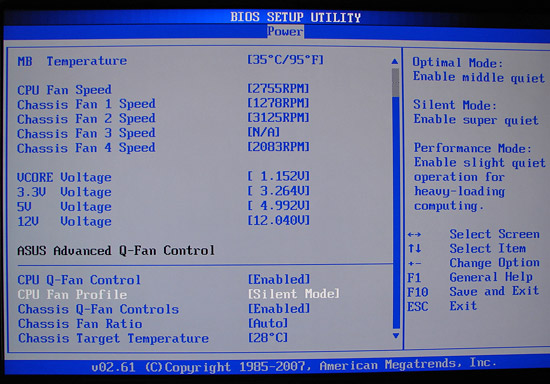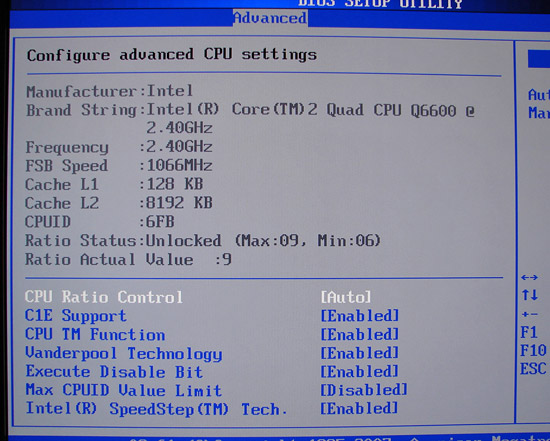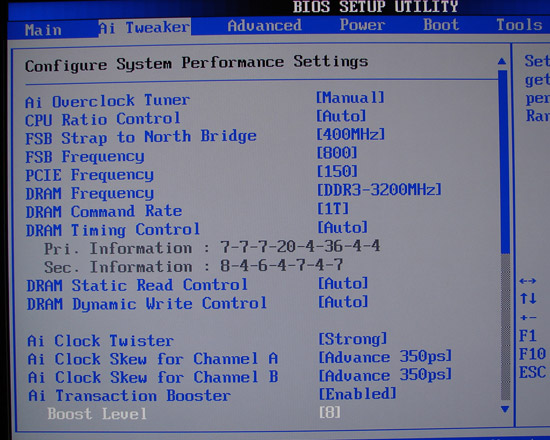ASUS P5E3 Deluxe: X38 and DDR3 arrives... almost
by Gary Key on September 18, 2007 4:00 AM EST- Posted in
- Motherboards
ASUS P5E3 Specifications and BIOS Overview
As mentioned, the P5E3 Deluxe board is designed for the general enthusiast with an emphasis on features designed for the home user, whether it is for gaming or home theater usage. ASUS provides two eSATA ports via the JMicron JMB363 chipset, IEEE-1394 support from Agere, excellent onboard audio support from the ADI 1988B, an 802.11n WiFi port, and dual Gigabit LAN capability. The board offers a very good mix of expansion slots, though utilizing a CrossFire setup will create the physical loss of a PCI-E x1 and PCI 2.2 slot. The third PCI-E x16 slot operates at x8 electrically and can be utilized for various PCI-E cards including AGEIA PhysX, RAID controllers, or a third video card. This slot will support a third ATI graphics card for "TriFire" operation once drivers are released with the proper support, according to our current information.
We will go into the BIOS settings in additional detail once we receive the retail kit and official launch BIOS. However, the following screenshots represent features that we know will be in the retail BIOS.

ASUS monitors the standard CPU fan speed and voltage readings. One item of note is that the BIOS monitors the CPU fan speed and four chassis headers but not the fifth header. Fan control is fairly limited when comparing it to abit's excellent uGuru setup with very simple options based on fan percentage speeds or base system temperatures. While the ability to individually control fan speeds is good, the speed options are too limited in our opinion for a board in the enthusiast category.

The advanced section of the BIOS contains the standard power saving options and an additional control for the CPU ratio.


The heart of the BIOS is under the AI Tweaker section with a wide variety of options for tuning the board. Although not as extensive as the typical DFI enthusiast boards, the options are fairly extensive with the notable addition being the 400FSB Strap setting in addition to 200, 266, and 333. Although not shown, the DRAM timing control section offers 15 different memory settings and hopefully they will remain in the retail BIOS.
ASUS has added the Ai Clock Twister option which basically offers slightly tighter sub-timings when set to strong. We noticed a slight decrease in latencies when utilizing this particular setting, but no tangible real world results that would matter to most users. ASUS has also revamped the Ai Transaction Booster setting when compared to their P35 boards. The old Transaction Booster setting of 0 on the P35 board is now 1 on the X38 board with the remaining ratios offering the same offset. Ratios 5 through 8 are new to the board although we could not get the board to POST with a ratio higher than 3.
Our screenshots show the maximum value for each option. Any setting greater than 1.77V for the Northbridge resulted in a warning for better chipset cooling. Although previous engineering samples of the X38 ran warm to hot when overclocking, our current sample stayed around 74C with 1.91V after two hours of looping 3DMark06. The available voltage options should satisfy about 95% of the users; however, we feel like the available CPU voltages are lacking when compared to the other X38 boards we have in-house as well as some of the upper-end P35 boards. ASUS has also included the ability to save BIOS profiles, although it is currently limited to two profiles.
| ASUS P5E3 Deluxe | |
| Market Segment | High Performance Enthusiast - $259.99 (estimated) |
| CPU Interface | Socket T (Socket 775) |
| CPU Support | LGA775-based Core 2 Duo, Core 2 Extreme, or Core 2 Quad Recommended |
| Chipset | Intel X38 (MCH) Northbridge and ICH9R Southbridge |
| Front Side Bus Speeds | Auto, 200 ~ 800 in 1MHz increments |
| DDR3 Memory Speed | Auto, Eight Ratios dependent upon Strap Setting |
| FSB Strap | Auto, 200, 266, 333, 400 |
| PCIe Speeds | Auto, 100MHz - 150MHz |
| PCI Speeds | Locked at 33.33MHz |
| Core Voltage | Auto, 1.10000 to 1.70000 in .00625 increments |
| CPU Clock Multiplier | 6x ~ 11x, downward adjustable for Core 2, upward to 50 for Extreme |
| DRAM Voltage DDR3 | Auto, 1.50V ~ 2.78V in .02V increments, 1.50V standard |
| DRAM Timing Control | Auto, Manual - 16 DRAM Timing Options (tCL, tRCD, tRP, tRAS, tRFC + 11 sub-timings) |
| DRAM Command Rate | Auto, 1T, 2T |
| NB Voltage | Auto, 1.25V ~ 1.91V in .02V increments, 1.25V standard |
| SB Voltage | Auto, 1.05V, 1.20V, 1.05 standard |
| FSB Termination Voltage | Auto, 1.20V to 1.50V in .02V increments, 1.20V standard |
| Clock Over Charging | Auto, .70V to 1.00V in .10V increments, .80 standard |
| CPU Voltage Damper | Auto, Enabled, Disabled |
| CPU Voltage Reference | Auto, .63, .61, .59, .57 |
| NB Voltage Reference | Auto, .67, .61 |
| AI Clock Twister | Auto, Light, Medium, Strong |
| AI Clock Skew CA/CB | Auto, Normal, 50ps to 350ps either advance or decrease |
| AI Transaction Booster | Auto, Enabled, Disabled, settings 1 to 8, higher increases performance |
| Memory Slots | Four 240-pin DDR3 DIMM Slots Dual-Channel Configuration Regular Unbuffered DDR3 Memory to 8GB Total |
| Expansion Slots | 3 - PCIe 2.0 x16 (2 - x16, 1 - x8 electrical) 2 - PCIe x1 2 - PCI Slot 2.2 |
| Onboard SATA/RAID | 6 SATA 3Gbps Ports - ICH9R (RAID 0,1, 10, 5) 2 eSATA 3Gbps Port - JMicron JMB363 |
| Onboard IDE | 1 ATA133/100/66 Port (2 drives) - JMicron JMB363 |
| Onboard USB 2.0/IEEE-1394 | 10 USB 2.0 Ports - 6 I/O Panel - 4 via Headers 2 Firewire 400 Ports by Agere FW3227 - 1 I/O Panel, 1 via Header |
| Onboard LAN | Realtek RTL8110SC - PCI Gigabit Ethernet controller Marvell 88E8056 PCI Express Gigabit Ethernet controller ASUS 802.11n Wireless Port |
| Onboard Audio | ADI 1988B - 8-channel HD audio codec |
| Power Connectors | ATX 24-pin, 8-pin ATX 12V |
| I/O Panel | 1 x PS/2 Keyboard 2 x eSATA 2 x SPDIF - Optical Out, Coaxial Out 1 x IEEE 1394 1 x Audio Panel 2 x RJ45 6 x USB 2.0/1.1 |
| Fan Headers | 6 - CPU, (5) Chassis |
| Fan Control | CPU and Chassis Fan Control via BIOS/AI Suite, PC Probe II monitoring |
| BIOS Revision | v1.4 |
| Board Revision | v1.0 |
As mentioned, the P5E3 Deluxe board is designed for the general enthusiast with an emphasis on features designed for the home user, whether it is for gaming or home theater usage. ASUS provides two eSATA ports via the JMicron JMB363 chipset, IEEE-1394 support from Agere, excellent onboard audio support from the ADI 1988B, an 802.11n WiFi port, and dual Gigabit LAN capability. The board offers a very good mix of expansion slots, though utilizing a CrossFire setup will create the physical loss of a PCI-E x1 and PCI 2.2 slot. The third PCI-E x16 slot operates at x8 electrically and can be utilized for various PCI-E cards including AGEIA PhysX, RAID controllers, or a third video card. This slot will support a third ATI graphics card for "TriFire" operation once drivers are released with the proper support, according to our current information.
We will go into the BIOS settings in additional detail once we receive the retail kit and official launch BIOS. However, the following screenshots represent features that we know will be in the retail BIOS.

ASUS monitors the standard CPU fan speed and voltage readings. One item of note is that the BIOS monitors the CPU fan speed and four chassis headers but not the fifth header. Fan control is fairly limited when comparing it to abit's excellent uGuru setup with very simple options based on fan percentage speeds or base system temperatures. While the ability to individually control fan speeds is good, the speed options are too limited in our opinion for a board in the enthusiast category.

The advanced section of the BIOS contains the standard power saving options and an additional control for the CPU ratio.


The heart of the BIOS is under the AI Tweaker section with a wide variety of options for tuning the board. Although not as extensive as the typical DFI enthusiast boards, the options are fairly extensive with the notable addition being the 400FSB Strap setting in addition to 200, 266, and 333. Although not shown, the DRAM timing control section offers 15 different memory settings and hopefully they will remain in the retail BIOS.
ASUS has added the Ai Clock Twister option which basically offers slightly tighter sub-timings when set to strong. We noticed a slight decrease in latencies when utilizing this particular setting, but no tangible real world results that would matter to most users. ASUS has also revamped the Ai Transaction Booster setting when compared to their P35 boards. The old Transaction Booster setting of 0 on the P35 board is now 1 on the X38 board with the remaining ratios offering the same offset. Ratios 5 through 8 are new to the board although we could not get the board to POST with a ratio higher than 3.
Our screenshots show the maximum value for each option. Any setting greater than 1.77V for the Northbridge resulted in a warning for better chipset cooling. Although previous engineering samples of the X38 ran warm to hot when overclocking, our current sample stayed around 74C with 1.91V after two hours of looping 3DMark06. The available voltage options should satisfy about 95% of the users; however, we feel like the available CPU voltages are lacking when compared to the other X38 boards we have in-house as well as some of the upper-end P35 boards. ASUS has also included the ability to save BIOS profiles, although it is currently limited to two profiles.










60 Comments
View All Comments
DigitalFreak - Tuesday, September 18, 2007 - link
Funny thing is, there were quite a few boards a year or two ago that had Firewire 800 (mainly from Gigabyte). Not sure why everyone is going back to Firewire 400.Gary Key - Tuesday, September 18, 2007 - link
Gigabyte use to have Firewire 800 and from all indications about a dozen (me included) people cared about it according to their marketing group, plus the cost was about double for the chipset. After speaking, sometimes pleading, the motherboard manufacturers are going to stick with Firewire 400 for the time being, originally most of the new boards were not going to have it.Hulk - Tuesday, September 18, 2007 - link
It's great to compare this new chipset to other current designs but a lot of people, like myself, are considering an upgrade from older designs. I have a P5B Deluxe and would like to see a 965 based chipset in the performance graphsgramboh - Tuesday, September 18, 2007 - link
I'm also a P5B Deluxe owner and I don't see much benefit to moving to P35/X38 at all. There might be a 3-5% performance boost and potentially better overclocking, but really nothing is different.I plan to wait for the next generation MB's and for DDR3 prices to drop. I might then upgrade my mainboard/memory in late 2008/early 2009.
FWIW I plan to drop in a 45nm Penryn quad core into my P5B-Deluxe in summer 2008.
Gary Key - Tuesday, September 18, 2007 - link
We will have comparisons to the older boards in the launch article, well, the article that will contain retail boards. Right now, our first retail board with the revised X38 will not arrive until this Friday. Monday might be just be a fluff PR article on the chipset specifics until we get at another board or two in.hifisoftware - Tuesday, September 18, 2007 - link
Good review.It's good to see DDR3 reviews once in a full moon (just to know where it stands performance wise), but 99% of people would rather see DDR2 review. DDR3 is just way, way more expensive without providing anything in return. I am looking for a new system so I want to know whether I should go with P35 or X38? Sounds like X38 will be more expensive and not much better (I do not care about running cooler, unless it can be translated to a higher overclock)
JarredWalton - Tuesday, September 18, 2007 - link
The quad-core FSB OC results are quite a bit higher than anything we've seen so far. Many quad cores have issues running at FSBs beyond the low 400MHz range. Then again, with the lowest quad-core having a 9X multiplier, I don't really see this as a huge limitation.hifisoftware - Tuesday, September 18, 2007 - link
Thanks. I guess then there is a reason for me to wait 2-3 weeks to decide if X38 price justifies it's OC abilities.n0nsense - Tuesday, September 18, 2007 - link
In your case will be smarter to wait for chipsets with PCIe 2 support.not to mention soon coming HybridSLI with 1600MHz support from Nvidia and X48 from intel.
and the Phenoms triple and quad cores will be released. Many new technologies. If it's not broken, let it work another half year.
n0nsense - Tuesday, September 18, 2007 - link
The passive cooling solution is good, but have some problem.The problem starting when you install this heatpipe cooled boards into cases like Enermax CS-718 (http://rusisrael.com/albums/pic/o/00/00/28/2863.jp...">http://rusisrael.com/albums/pic/o/00/00/28/2863.jp.... According to Asus support, "After all, the board is not designed to be installed "upside-down"" and they suggest to consider other cooling solutions in case of overclocking. It took me more then a week to get straight answer for the question "Does installation direction have negative affect on cooling". The question was asked about my P5N32-E SLI, but i suspect it remains true for all boards with heatpipe cooling solution. What is disappointing me most, is the fact that this information not found on Asus's site as "case compatibility" or "installation directions" or some other kind of note or warning.